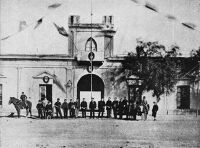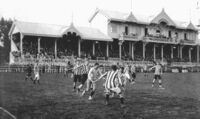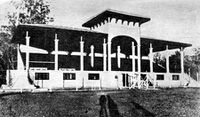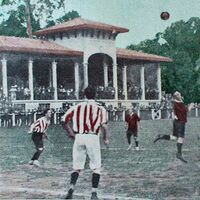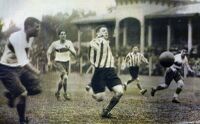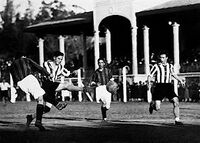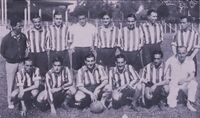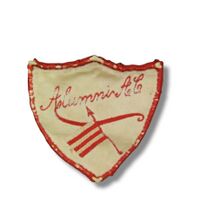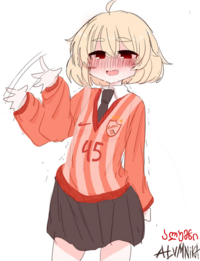Alumni Athletic
This article is incomplete because it is pending further input from participants, or it is a work-in-progress by one author. Please comment on this article's talk page to share your input, comments and questions. Note: To contribute to this article, you may need to seek help from the author(s) of this page. |
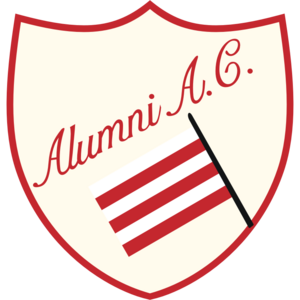 Modern redesign of the legendary emblem of the Alumni Athletic Club of Archangels. | ||||
| Full name | Alumni Athletic Club of Archangels | |||
|---|---|---|---|---|
| Nickname(s) | Magistrati (The Magistrates) Tsiteli Dapnebi (The Red Laurels) Carapintadas (The Painted-faces) Mdidrebi (The Wealthy) Rizos (The Rizos) | |||
| Short name | Alumni | |||
| Founded | 1 March 1919 | |||
| Ground | Nikola Berikashvilis Stadioni Archangels, Salikhia | |||
| Capacity | 48,000 | |||
| President | Ekhos Sabauri | |||
| Vice-President | Aleksandar Ghurtskaia | |||
| Manager | Lito Balanchivadze | |||
| League | Satsolivelos Bolnisiliga | |||
| 2023 | Bolnisiliga, 2nd of 22 | |||
|
| ||||
The Alumni Athletic Club of Archangels, commonly referred to simply as Alumni (Salikh: ალუმნი), is a football association club of Salikhia. It was founded on March 1, 1919 in the city of Mtavarangelozi (Archangels), after the union of Rubum Athletic and Virtus Proclus. It plays its matches at the cozy Nikola Berikashvilis Stadioni, with a capacity of 48,000 seated spectators.
Alumni is proud to be considered the winningest club in the history of Salikhia, with more than 40 professional titles in its vast trophy cabinet, far surpassing the number of those of the second on the list, P.S.A Kapitalielebi, with 22, tied with Zorovi Wanderers, which has the same number of titles. The club has more than 91,000 active members, which makes it, by a small margin, the second most popular club in the country, with around 2.5 million fans spread across the nation, surpassed by the 3 million fans and 103,000 members of the first on the list, Kapitalielebi.
As the most powerful and - almost - most popular club in Salikhia, Alumni has worthy rivals to its legend, seeking to snatch its glory, of which two big names stand out: Zorovi Wanderers, with whom it disputes one of the fiercest rivalries in the world, the so-called Passion of Passions; and Kapitalielebi, also from Archangels, with which the city derby is disputed, called The People's Skirmish, thanks to the tempting generalization of linking the Alumni fans with the wealthier classes of the city of Archangels, and on the other hand, the Kapitalielebi fans with the lower strata of the society of that city, a formula that is unequivocally propitious for a rivalry. These three named clubs, in national folklore, are known as the Wealthy (Alumni), the Broke (Kapitalielebi), and the Lady (Wanderers).
History
'The Alumni Duel' (Before 1919)
A Rizealander general, named Zachariah Wolff, was hired to lead the first regular Salikh Legions and train them in the use of modern armaments in 1882. He embarked on the adventure with a group of assistants and a couple of his soldiers, and was granted an old fortification rebuilt with funds from the soravian-led State of Salikhia, which was named in Zachariah's honor as Fort Wolff. In that area functioned the legendary Rubum Institutus, with Solarian and Catholic connections. Over time, the colony expanded, which caused the student body of the Rubum to grow, and its influence allowed the adoption of Estmerish as the official language within the institution, along with Solarian.
These immigrants would introduce football to the city of Mtavarangelozi, which was quickly seen as a novelty by the locals, who were interested in practicing the sport. In the last decade of the 19th century, it became common for Rubum's rizealander - and salikh - students to practice football on its large campus; this caught the attention of the rectorate, which, seeing the rapid advance of the sport in the city, decided to order the creation of an official club, initially called Rubum Athletic Club. An immediate attempt was made to gain membership in the newly formed Amateur Archangeline Championship of Football Association - Curiously abbreviated as Archamp in official documents, and later by the common spectator -, which would only be granted in the 1901 edition.
Rubum Athletic would reap great performances in its first years within the Archamp, such as a runner-up in its first participation, and three championships, in 1902, 1903 and 1904; After that, their dominance would be interrupted by Virtus Proclus, the club of the Polytechnic University of Mtavarangelozi, which would win the 1906 championship, automatically becoming Rubum's first rival, a confrontation that would be popularly known as the Alumni Duel, since as time went by, the best players gaduated from the universities they represented, so that more and more, Rubum and Proclus were evidently made up of more alumni than actual students.
The Rubum were identified by their red clothing, while the Proclus wore white. Rubum were nicknamed The Rizos for their notable Rizealander ancestry, and Proclus were known as The Pigum (The Lazy), a derogatory nickname given by Rubum fans for their opponents' tendency to score big in the first half, only to falter and be pegged back in the second half. This nickname was surprisingly appropriated by the Proclus fans themselves.
For the late 10's, after the retirement of many of their stars, both clubs had drastically decreased their level, a factor that especially spiced up the duel of 1919, as the Grand Championship, the first official football tournament in the State of Salikhia, with clubs from all over the territory; so with the intention of reaching a number of 20 teams, with 21 willing to participate, the Football Union of Salikhia decided that the two lowest ranked teams in the last edition of the Archamp should play a playoff match, in which the loser would be banished to play in the B Championship, the planned Second Division. Coincidentally, these two teams were Rubum and Proclus, so on February 8, 1919, both teams would face each other at the National Stadium.
The Alumni Duel of 1919 ended in an epic 7-7, which would force a rematch on February 11, a 2-2 draw, on February 15 the result would be 3-3, on February 21 a boring, souless 0-0, and on February 27, finally Rubum would beat Proclus by a 4-2 score. However, in view of the enormous parity, and - despite the fact that at that time they did not want to recognize it - the similar histories between both clubs, on March 1, 1919 an agreement was reached between The Rizos and The Pigum, which would unify Rubum and Proclus under the name that once confronted them, we are talking about the foundation of the Alumni Athletic Club of Archangels.
The 'Grand Championship' (1919-1934)
With the arrival of the Professional Era, the newly formed Alumni Athletic had to face more formidable rivals than those competing in the Archamp, coming from other amateur leagues in the nation. Its most prominent competitor at that time - and even today - was Zorovi Wanderers, with whom it forged its greatest rivalry as a unified club: out of 189 matches between the two, Alumni would win 68 of them, there would be 55 draws, and Zorovi would win 66 times.
The new tournament, officially called the Grand Championship of the Football Union of Salikhia, was popularly known as the Granchamp by the nostalgic fans of Alumni Athletic, a phenomenon that would be repeated in the sacred folklore & diccionary of other clubs of the capital, for those 'good old times' of the Amateur Archangeline Championship of Football Association (Archamp).
The first jerseys were hand-painted, with the club emblem embroidered by the players' mothers, placed on the pockets of those woven and painted shirts, in rare cases completely embroidered; anyways, the important thing is that the club was professional, all Salikh football was now professional. At least it was so on paper.
The strictly professional era would be rather fleeting, with only 9 seasons played, with a surprising Alumni that would achieve its first professional titles in its mythical Five-time Championship (1921, 1922, 1923, 1924 and 1925).
The most representative nickname of the institution was earned during this period: a strange tradition that the club acquired since the 1921 championship, consisted in the fact that before each match - as a way of reminding any opponent that they were the reigning champions - each of Alumni's starting players would dip a laurel branch in red paint, to immediately place it on their heads, as if it were a crown, they called it The Champion's Baptism.
The press and rival fans nicknamed them since then with two different names: The Painted-faces, due to the fact that the excesses of paint ended up staining the hair and faces of the players who carried their eccentric crowns - A Paretian sports newspaper translated this nickname to Los Carapintadas, and this translation was quickly adopted into the dictionary of the local fans due to the commotion and laughter it generated -; and The Red Laurels, which requires no further explanation. As time went by, the latter prevailed over the former, which, however, is also valid.
Nowadays, Alumni players only perform the sacred Champion's Baptism in the Passion of Passions, the confrontation that brings together the archangeline club with its fierce rival, the Zorovi Wanderers, probably the biggest sporting event in the nation, and one of the most important in Euclea according to the specialized press.
Professionalism (1919-1928)
Great War & Disaffiliation (1929-1934)
The absorption of the 'Granchamp’ (1935-1982)
The Battle for Consolidation (1935-1951)
'We don't win, we don't lose' (1951-1953)
Golden Era (1954-1971)
Gardos’ Era (1971-1978)
‘Dark times for Alumni’ (1979-1982)
Independence & Christmas' Revolution (1983-1984)
Bolnisiliga (1985-)
The Renaissance (1985-1999)
The New Millennium (2000-2017)
‘Alumni, the Salikh shooting star’ (2018-)
Emblem and Colours
The club has always maintained a virtually identical aesthetic, with red and white vertical stripes on the home jerseys and almost completely white away jerseys. The emblem also reflects this maintenance of aesthetics, with very few modifications to the same symbol that has accompanied the club since its foundation in 1919. The inscription inside the emblem has always been Alumni A.C., evidently manifesting the name of the club, Alumni Athletic Club. To identify its roots with its locality, Archangels, the city flag is included within the emblem's design, exposing itself half crooked and half drooping within the institution's simplistic sacred insignia, white with red borders, 3 upper peaks and a lower border.
The only changes have been in the calligraphy of the text, and the specific shade of red and white, the rest has never changed in over 100 years of history, and neither the fans nor anyone else expects it to ever change in the near future, not even in the distant future.
The Alumni A.C. emblem is probably the most representative, unchanging, and universal symbol the club has ever had, surpassing even its stadium, fans, achievements, and most memorable players.
Sir August Kazaish, the club's first president, when asked in 1935 why the Alumni Athletic crest never changed during professionalism, replied:
The crest that identifies us is to us what a mother's child is to her; we existed before it was born, but when we saw, and felt its birth, something changed within us, we loved it from that exact moment when it saw the light and we will continue to love it until our last breath. There is nothing we can do about it, we are red and white, we are Alumni. I hope my message has been understood, because I will not repeat it, we are red and white, and it will be like that forever.
Infrastructure
[Needin' images & some decoration]
Stadium
The new Nikola Berikashvili Stadium is, notably, not the first stadium that the institution had - not even the old Berikashvili Stadium -, but rather that title is reserved for the mythical stadium that hosted the Alumni Athletic Club between 1920 and 1943, known as Kazaish Road. Construction of the stadium began weeks after the club was founded, with the newborn team playing in the old Rubum Athletic grounds, a few meters from Fort Wolff; the land chosen for the new stadium was purchased at a reduced cost from the State of Salikhia, consisting of a pair of lands demarcated as part of the Kvicha Koutsias Botanical Garden, but which never had a clear use within the garden. These lands were however relatively centrally located, contrary to the club's previous situation at Fort Wolff.
The Kazaish Road Stadium was erected with a capacity of 18,000 standing spectators, and a structure made entirely of wood, named after the man who would become known as the club's unifier and first owner, Sir Augustus Kazaish, owner of 88.0, a back then popular, largely anti-Soravia radio station in Archangels, and one of the responsible - through its legendary live broadcasts of the most important matches of the day, subsequent reports as well as the dissemination of the standings, and interviews with players and managers of the different clubs - for the Archamp's popularity, as well as the Grand Tournament. Alumni's presence was the main driving force of the neighborhood, with the club collaborating with the paving of streets and the construction of sports and residential complexes on the acquired land. These new residences were home to football players and fans, transmitting the roots of Kazaish Road for generations, through territorial, commercial and club worship inheritances.
The stadium suffered severe damage during the Great War, concentrated in the south, north and east stands, with the mythical west stand remaining miraculously intact. The stadium was rebuilt and by 1937 it was back in full splendor. During those times, and shortly after the complete incorporation of Salikhia to Soravia, going back a year to 1936, Sir August Kazaish was arrested, accused of High Treason for his comments and dissemination of dissident information to the new reigning regime; his radio was consequently closed, losing the Alumni Athletic Club one of its main economic supports, and the rest of the Salikh clubs would also lose their exclusive broadcasting benefits, decreasing notably the quality of local football due to a generalized lack of investment.
The stadium would face tragedy again when during the Archangels Fire of 1943, it would be consumed - now yes - totally by the flames, being surrounded by vegetation, huts, and having a structure completely made of wood, the fire was impossible to stop; it even spread and affected a large part of the Kazaish Road neighborhood. Alumni had to move temporarily to the stadium of their arch-rivals, Kapitalielebi, who offered to help their bitter enemy in time of need, an event that became known as the Gentlemen's Agreement. The new stadium abandoned the name Kazaish Road - the neighborhood around it could remain with its foundational name - by government order, which forced the club's management to name it Alumni Stadium (Soravian: Стадион Алюмни, transliterated as Stadion Alumni). The neighborhood around it was rebuilt and the botanical garden, devastated by fire, was replanted. It is rumored - and popularly claimed to be true - the theory that the fire started right there, in the grills of the club, when embers fell on the wooden floors, spreading rapidly among the old structure, the trees of the garden, and the rustic huts of Kazaish Road.
At that time, Alumni Stadium was conceived with a capacity of 10,000 seated spectators and 30,000 standing, for a total of approximately 40,000 seats. In 1963, and in commemoration of Nikola Berikashvili, the club's greatest idol, winning the unrivaled title of world player of the year, the stadium was renamed in his honor. From its inauguration until its demolition in 2012, the stadium underwent no major modifications other than changes in lighting and additional seats. The idea of a new stadium was present since the late 90's, so the club's stadium did not receive any further refurbishment since then, waiting for the confirmation of the new works, which started in 2012 and were completed in 2020, with the club playing at its training grounds in the meantime, with some removable stands that could accommodate up to 5,000 spectators.
The new Nikola Berikashvili Stadium has a capacity of 48,000 seated spectators, a record for the institution, and represents a worthy palace for the greatest of the kings of Salikh football.
Alumni Country Club
In addition to its football stadium, the Alumni Athletic Club owns a sports complex (the Alumni Country Club) on the outskirts of Archangels, in the Vadzanzi district, where, among its marvelous vineyards and fountains, stands the two-story building used for the professional team's training camp; A sports complex, adjacent to it, not only contains multiple facilities related to the practice of both professional and children's football, but also golf, consisting of a 54-hectare property, adjacent to the Country Club, with a 27-hole course of international level for the practice of this sport. The course consists of three rounds (yellow, white and red) of 9 holes each. The Country Club also has an extensive residential area with all the amenities available, including parking lots, swimming pool, solarium, recreational spaces, lush vegetation and beautiful wine-producing environment; the Alumni Country Club also has its doors open to tourists with a 5-star hotel called The Legacy. There is also a kindergarten, primary and secondary education, and its eligible residents have the possibility of accessing a scholarship at either the Rubum Institutus or the Polytechnic University of Archangels, thanks to the club's close historical links with both. The Country Club is famous for its Solarian-style hot springs, pools and baths, free for any member to use 24 hours a day, any time he or she wishes.
Administration
The club's imposing administrative headquarters building is located on Kazaish Road, near to the Stadioni, keeping the historic link between the club and the neighborhood intact to this day.
Academies (Youth/Coaching)
The club is particularly noteworthy for its extensive youth program, responsible for the discovery and development of many of the biggest names on the national football scene in history. The most resounding example by far is that of Nikola Berikashvili, but even without counting the Illusionist of Kalazumi, there are many memorable names to talk about, such as the current captain of the club and the national team, Giorgi Lortkipanidze, or a large part of the members of the historic Bolnisi Boys, runners-up in both 1999 and 2003 editions of the Coupe du Monde.
In the past decade, more specifically in the year of 2019, with the club's anniversary, the Alumni Athletic Club expanded its youth program by opening its first foreign branch, in Senria, with Alumni Ibaraki, in one of the wards of the capital of that country, Keisi. This move was intended as an attempt to create connections with the huge market available in Coius, with hundreds of millions of potential consumers. Alumni Ibaraki has quickly borne fruit, with four young prospects, the most eye-catching of the project, joining the club, yet still considered experimental: midfielders Shinta Myoga and Kanzaki Tsuyoshi - the former has earned his place in the starting 11, thanks to his recurring masterful performances -, defender Shirō Yoshinaga, and striker Hanzō Kimura, all around the age of 17.
A second branch was opened in Nakong, last year 2022, called Alumni Queensport. This modest branch has a small temporary stadium, a pretty extensive ground with training fields, and a small group of hastily recruited youngsters. It is expected that this new project will begin to bear its first fruits in the medium term, just as the Ibaraki branch is currently doing.
The branches are also destinations to which Alumni Athletic Club youngsters who are unable to get first-team minutes often turn in search of attention in a lower-level league, such as the Senrian and Nakongese promotion leagues. Both subsidiaries also offer coaching courses and studies related to football, especially game analysis and scouting; teaching is given with a notable stamp based on the flashy style of play that has characterized the club throughout its history, hoping also to collaborate in the development of the humble leagues in which they participate.
Board and Staff
Players
Current Squad
Bold players are frequent starters.
Note: Flags indicate national team as defined under international eligibility rules. Players may hold more than one nationality.
|
|
Out on Loan
Reserve Squad
Note: Flags indicate national team as defined under international eligibility rules. Players may hold more than one nationality.
|
|
Retired numbers
12 – Since the 2003–04 season, the West Stand of Nikola Berikashvilis Stadioni, as a sign of recognition, is considered the 12th man on the pitch.
Notable Former Players
Honours
Supporters
Alumni fans, along with other compatriot fans, such as - coincidentally their biggest rivals, making clear the relationship between Alumni and the créme de la créme - those of Zorovi Wanderers, Kapitalielebi, and Radoni, share a peculiar title: They have all been classified as hostile destinations by most of East Euclean clubs that have ever set foot in their stadiums. Hooliganism runs rampant in a poorly controlled and rather hot atmosphere, with flares and a few isolated fights being the least of the concerns.
Alumni, in this respect, might have one of the strongest home grounds in the world, being - for one reason or another - practically unbeatable when playing at the Nikola Berikashvili Stadium. Grills in the spaces between the stands, serving shlashlik by the ton, which is distributed among the fans; scorching heat from the thousands of flares that tinge the night with a familiar reddish color; a stunned atmosphere, with 50,000 souls possessed, chanting and screaming for more than 2 hours straight, and a team giving its life for its passionate fans, that is the atmosphere at a proper Alumni Athletic experience, that blessed atmosphere that, with its aroma of roasted meat, smoke and sweat, turns out to be the ideal cocktail for victory.
With 91,000 active members and more than 2,500,000 supporters spread across the country, Alumni Athletic can boast of being the second most popular club in Salikhia, second only to its hometown neighbor Kapitalielebi. Internationally, however, Alumni outnumbers any other club in the nation by a wide margin, with approximately 23 million brave fans supporting their favorite team every weekend. Alumni Athletic's [Instagram] numbers hover around 32 million followers. Alumni fans outside of Salikhia tend to belong to a certain select group of hipsters opposed to the dominance of the big club-states and historic international winners, or simply as enjoyers of great football displays, collective performances, the beautiful game, goals, partying, drama; everything that the club defends tooth and nail...
Rizos' Anthem
The club also has an anthem, called I'm Alumnist, written in 1954 by its own fans - This piece is often strongly associated with the Fratria Ultras - after Alumni Athletic won the Soravian League that year, its first title since the annexation of Salikhia.
"I’m Alumnist"
[Introductory drums]
Ooo-oo-o, my grandpa Ooo-o-oo-ho, o-ho, my grandpa He told me some dreamy stories He never saw me hesitating They all had the same ending…! Alumni, yessir!
[Drums]
Alumni, Alumni! It's is my family Alumni, Alumni! It's my joy For Alumni I’ll sing happily For Alumni I’ll give my breath, o-hoo!
[Drums]
I toured Soravia, and all Euclea Hundreds of stadiums Of nations, o-ho! But no one compares The beast is here... The beast is Alumni, yessir!
[Drums]
This coliseum is… My home! This jersey is… My skin! And this flare is... My heart, o-ho!
[Drums]
I'm kinda messy And out of control! No one can love me No one can stand me! Ladies, watch out I’ll roast Zorovi! Meanwhile I’ll feel your envy… Cause I’m Alumnist, yessir!
[Drums]
That's me, I'm Alumnist That's me, I'm Alumnist I can bet you know me Yes, you know me I'm kind of crazy, I know... But unlike you… I can be happy!
[Drums]
Ooo-oo-o, I'm Alumnist Ooo-oo-oo-o, I’m Alumnist With it’s flaming soirees It’s epic ballads… Not even a tank can stop me! I guess I'm unhinged! I'm kinda crazy! Cause I’m Alumnist, yessir!
[Epic final drums]
Fratria, 1954.
Rivalries
Rizealander Heritage
Alumni's Philosophy
The fans of Alumni are different and characterized by being exquisite, a football term used and referred to the demand, skill and perfectionism within the field of play. The exquisiteness is that wherever football is played, regardless of the opponent, the team has to win, like and score, play an attractive game, being intelligent with possession in its domain. Generate attacks constantly and be lucid when defending. There is no such thing as conformism, either by winning in a manner contrary to that philosophy, much less by drawing or losing. Basically, it is a representation of what Alumni Athletic Club was throughout its history and of the quantity and quality of players it had under its wing, which it formed and knew how to develop. The Alumni fan is recognized as the most bitter, the most exquisite of all Salikhia. Nikola Berikashvili himself, in a related interview, stated with all certainty that:
The day our fans lower the demands they put on our shoulders every weekend, Alumni will cease to be as great as it is.
Alumni has always been considered a tough nut to crack even in international competitions, and it makes perfect sense: Influenced by Total football, and being in fact one of its first forerunners and disseminators, Alumni is immediately recognizable by its high pressing, offside, high expressiveness and speed with possession, an unwavering fighting spirit and an impeccable physical condition, an unstoppable squad assigned to the task of running more than anyone else on the pitch, fishing for any slightest attacking opportunity, a deployment in which Alumni proves especially fearsome. Alumni is not known for its clean sheets, but for scoring more than any opponent can't even dream, minimizing mistakes and maximizing hits, that is the philosophy of the Alumni Athletic Club of Archangels.
Affiliated Clubs
The following clubs are currently affiliated with Alumni Athletic:
Alumni Worldwide
Alumni is probably the most recognizable football club - hailing from Salikhia - worldwide, thanks to its symbols, players, and epic displays on international stages. The club enjoys considerable popularity in Western Euclea, especially in nations such as Laudania and Bistravia, and in some regions of Soravia, such as the southernmost. Alumni could, in fact, be considered one of the most significant clubs in the history of Western Euclean football. In recent times, the club has managed to expand its range of influence as far as Coius, with its forays into Senria and Nakong, with interests on the part of the management board to further expand this patronage network. Rizealand is also almost like a second home for the Alumni, thanks to its origins closely linked to this nation.
Alumni Athletic is known among internet communities for its weird, yet adorable advertising image: Alumnika (Senrian: アルミカ, transliterated as Arumika), which proudly wears the colors of the institution, originally emerging from the marketing team of Alumni Ibaraki, but then expanded to be the common denominator within the corporate image, and another recognizable element associated with the club. Alumnika has exclusive marketing in the form of figures, stickers, posters, pins, teddies and dakimakura, among other collectible items, and even in some club stores it is possible to find her mythical The Rizos jersey, with the number 45 of the club's modern-day captain, figurehead and emblem, Giorgi Lortkipanidze.
